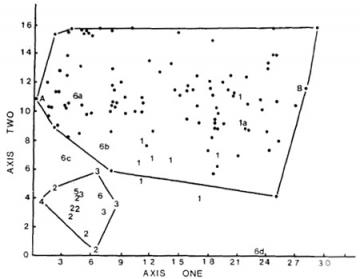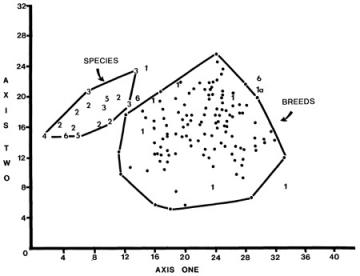Summary of problems:
The claim that there are limits on evolution as evidenced by the limits on the speed of horses or the size of domestic dogs is essentially a restatement of the creationist doctrine that types (or baramins) cannot evolve into one another. Explore Evolution argues that if natural selection cannot produce a certain change in a matter of decades, it could never produce that change. This is nonsensical on its face, and does not accurately reflect basic knowledge about natural selection and population genetics stretching back to the 1920s. It also misstates the effects that animal husbandry has been shown to have on domestic species.Full discussion:
Explore Evolution invites readers to imagine a dog as small as a pair of glasses, or larger than a horse, concludes "this is comical," and states that unnamed "critics" think "there are limits to how much an animal can change [via natural selection]" (p. 90). Setting aside that natural selection does not change "an animal," but operates over many generations of a population or species of animals, plants or other organisms, the claim that limits on natural selection are such that they would prevent speciation or other "large-scale changes" is simply not correct.
Explore Evolution states that "Horse breeders have not significantly increased the running speed of thoroughbreds, despite more than 70 years of trying" (p. 90), a claim which is inaccurate on at least one count, and which misrepresents the source they cite. Gaffney and Cunningham (1988), the paper they cite to justify the sentence, do find that winning race times have not changed, but end the paper stating, "We conclude that the explanation for the lack of progress in winning times is not due to a lack of genetic gain in the thoroughbred population as a whole." Genetic gain in the population as a result of selective breeding is the very definition of selection. Furthermore,
breeders and horse-racing enthusiasts state they pay little attention to winning times. Instead, riders, horse owners, breeders, and bettors are rewarded for horses that win races, regardless of time, and little effort is made to "beat the clock." Furthermore, "fast tracks" are notoriously bad for the health of horses, causing damage to bones and tendons. Consequently, track surfaces are often treated to be softer, slower, and less likely to cause stress on the horse. Thus, modern racetracks may be slower than the tracks of 50 years ago.Ernest Bailey (1998), "Odds on the FAST gene," Genome Research, 8(6):569-571
Thus, it is not the case that horse breeders have tried to increase the absolute time in which their horses complete races, but to ensure that their horses run faster than the other horses in a given race. It is therefore impossible to know whether contemporary horses would run faster than famous racehorses like Seabiscuit or Secretariat if they ran against one another, or whether contemporary horses as a whole are faster in absolute terms than horses were 70 years ago.
The book's dismissal of variation within dogs is, if possible, even more disingenuous.
 Dog limbs vs. wild canids: Fig. 7 from Wayne (1986), "Limb morphology of domestic and wild canids: The influence of development on morphologic change," Journal of Morphology 187(3):301-319. It shows an analysis of limb measurements from several species of domestic dogs (dots), other members of the genus Canis (labeled 1), fox-sized species (labeled 2-5) and other species: la) Canis lupus, the grey wolf; 6a) Speothos venaticus, the bushdog; 6b) Nyctereutes procyonoides, the raccoon dog; 6c) Atelocynus microtis, the short-eared dog; A) Chihuahua; B) Irish wolfhound.
Dog limbs vs. wild canids: Fig. 7 from Wayne (1986), "Limb morphology of domestic and wild canids: The influence of development on morphologic change," Journal of Morphology 187(3):301-319. It shows an analysis of limb measurements from several species of domestic dogs (dots), other members of the genus Canis (labeled 1), fox-sized species (labeled 2-5) and other species: la) Canis lupus, the grey wolf; 6a) Speothos venaticus, the bushdog; 6b) Nyctereutes procyonoides, the raccoon dog; 6c) Atelocynus microtis, the short-eared dog; A) Chihuahua; B) Irish wolfhound.It shows that dog limbs are much more varied than those of all other members of the family Canidae, including foxes, wolves, and coyotes.
 Dog skulls vs. wild canids: Fig. 3 from Robert K. Wayne (1986) "Cranial Morphology of Domestic and Wild Canids: The Influence of Development on Morphological Change," Evolution, 40(2):243-261. It shows an analysis of skull measurements from several species of domestic dogs (dots), other members of the genus Canis (labeled 1), fox-sized species (labeled 2-5), other species (labeled 6), and Canis lupus, the grey wolf (labeled 1a). As with limb morphology, the variability in skull size and shape in dogs exceeds that found within all other canids. Morphometric studies of dog limbs and skulls have found that the variation within the domestic dog, Canis familiaris, is greater than the variation within the entire family to which that species belongs, and indeed greater than the variation within the order Carnivora. The range of sizes is many times greater (axis 1 in both figures). The shapes of the dogs' limbs (axis two in the first image) only slightly overlap the shapes found in other canids, including other members of the genus Canis. The shapes of the skulls (axis two in the second figure) completely overlap the shapes of non-Canis canid skulls, and the range of dog skull shapes is matched only by variation among other members of the genus.
Dog skulls vs. wild canids: Fig. 3 from Robert K. Wayne (1986) "Cranial Morphology of Domestic and Wild Canids: The Influence of Development on Morphological Change," Evolution, 40(2):243-261. It shows an analysis of skull measurements from several species of domestic dogs (dots), other members of the genus Canis (labeled 1), fox-sized species (labeled 2-5), other species (labeled 6), and Canis lupus, the grey wolf (labeled 1a). As with limb morphology, the variability in skull size and shape in dogs exceeds that found within all other canids. Morphometric studies of dog limbs and skulls have found that the variation within the domestic dog, Canis familiaris, is greater than the variation within the entire family to which that species belongs, and indeed greater than the variation within the order Carnivora. The range of sizes is many times greater (axis 1 in both figures). The shapes of the dogs' limbs (axis two in the first image) only slightly overlap the shapes found in other canids, including other members of the genus Canis. The shapes of the skulls (axis two in the second figure) completely overlap the shapes of non-Canis canid skulls, and the range of dog skull shapes is matched only by variation among other members of the genus.There is no evidence in these data to suggest that dogs have reached any inherent limits to their evolution or to the powers of natural selection. What these data show is that dog breeders have already managed to produce animals which break new morphological ground. Whatever limits might seem to exist if we look at the shapes and sizes of wild canids have been surpassed by the work of dog breeders. Whatever limits natural selection has, they have prevented the evolution of variation beyond that seen within the rest of the entire order Carnivora (dogs, cats, bears, foxes, weasels, etc.), all within the last few thousand years. Natural selection may well have limits, but if the limits are that loose, they would not prevent the diversification of life as we know it over the course of several billion years.
There is little doubt that limits on natural selection do in fact exist. Because selection operates on existing variation, there is a balance between the rate of mutation and the force of selection. This balance was first described in the 1920s, and modern textbooks describe this mutation-selection balance (e.g., p. 115 in Ridley's Evolution, p. 438 in Futuyma's Evolutionary Biology, or p. 461 in Campbell and Reece's Biology). In a hypothetical case where mutation does not occur, strong enough selection would eventually stabilize all of the genes relevant to a given trait. Similarly, in the absence of selection, mutation would gradually increase the number of mutants in the population to some equilibrium. Depending on the amount of selection and the amount of mutation, the amount of variation available to select on will vary.
The limits selection might face because of limited natural variability within a single generation will get progressively broader as the number of generations increases. Modern racing horses can trace over half of their genes to 10 horses of the late 18th century, and over 80% to only 31 ancestors from that era. Despite that highly constrained gene pool, the speed of horses has risen (whether or not it plateaued in the 1950s as discussed above). Similarly, much of the morphological evolution in dogs took place over a similar time period, beginning in the 18th century as breeders began paying more careful attention to studbooks.
